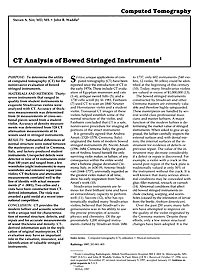 Publication: Computed Tomography, June 1999
Publication: Computed Tomography, June 1999
CT Analysis of Bowed Stringed Instruments
Steven A. Sirr, MD, MS & John R. Waddle
Download PDF of full article
PURPOSE: To determine the utility of computed tomography (CT) for the noninvasive evaluation of bowed stringed instruments.
MATERIALS AND METHODS: 37 instruments that ranged in quality from student instruments to exquisite Stradivarius violins were analyzed with CT. Accuracy of thickness measurements was determined from 24 measurements of cross-sectional pieces sawed from a student violin. Accuracy of density measurements was determined from 328 CT attenuation measurements of 16 woods used in stringed instruments.
RESULTS: Substantial differences of normal structure were noted between the masterpieces crafted in Cremona, Italy, and factory-produced student instruments. Unexpected defects were detected in nine of 14 instruments older than 100 years and ranged from a few wormholes (eight instruments) to many wormholes and extensive repair (one violin). CT thickness and attenuation measurements correlated well to the line of identity with actual measurements (P < .0001). Two cellos and a viola have been constructed from CT derived information. The viola was awarded a gold medal at a recent international competition.
CONCLUSION: CT provides the modern luthier and acoustic scientist with a unique tool for characterization of normal structure, defects, and repair and for accurate measurements of wood thickness and density. CT derived information aids in the replication of original masterpieces. CT evaluation may have an important role in the valuation, insurance, and identification of valuable stringed instruments.